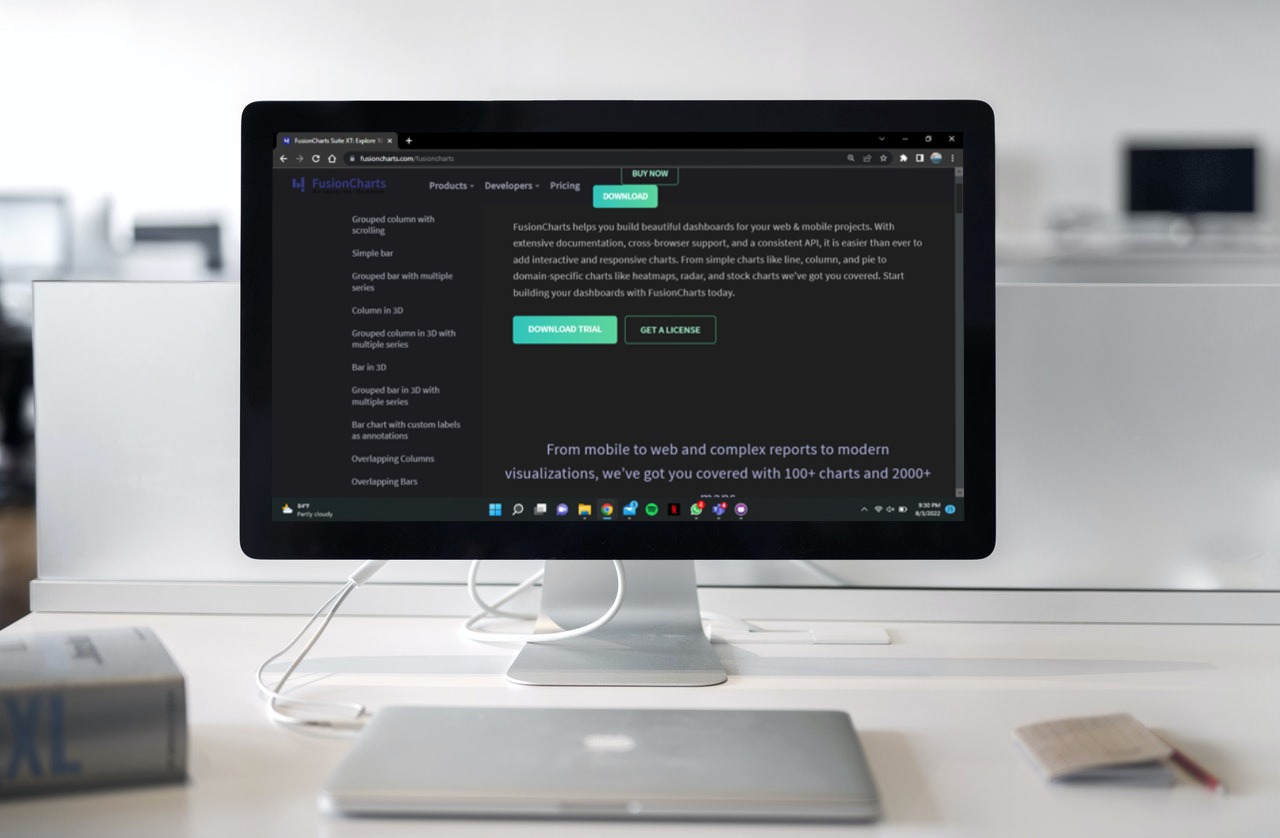Data visualization focuses on presenting raw data through visual representations like graphs or charts. Even for folks who aren’t naturally quantitative or analytic, data is easier to comprehend and processes more quickly when presented visually. Additionally, using a JavaScript chart to communicate ideas is common. This article will teach you how to avoid these typical errors when building JS charts.
 Data visualization is of paramount importance today, especially when creating JavaScript charts.
Businesses need to use data visualization tools to emphasize the most crucial information so audiences can understand these facts and take action. So, business users may understand their massive amounts of data using data visualization. Recognizing new patterns and data mistakes is advantageous to them. Understanding these patterns enables users to focus on areas with warning signs or advancements.
Anyone gathering data may find it highly interesting, but the target audience may not. This is particularly true when there is a lot of data to exchange.
To provide a clear message about your data, visuals also leverage the potential of data storytelling. This helps the material become meaningful and relatable. Colors and patterns catch the attention of the human eye. Our brains are superior at information processing. Another sort of visual art is data visualization. This kind of storytelling grabs our attention, keeps it, and enables us to participate.
As one of the most popular client-side scripting languages, JavaScript is heavily utilized to produce visually appealing data visualizations for current online and mobile browsers. You can create a graph using the information retrieved from an outside source or provided in line. In addition, you can use one of the many libraries that allow graphing and charting. Many JavaScript charting libraries are used as references in other JavaScript files to create charts and graphs.
FusionCharts, HighCharts, ChartKick, and Chart.js are a few of the JS charting frameworks. Later in the article, we will go into more detail about charting libraries.
Data visualization is of paramount importance today, especially when creating JavaScript charts.
Businesses need to use data visualization tools to emphasize the most crucial information so audiences can understand these facts and take action. So, business users may understand their massive amounts of data using data visualization. Recognizing new patterns and data mistakes is advantageous to them. Understanding these patterns enables users to focus on areas with warning signs or advancements.
Anyone gathering data may find it highly interesting, but the target audience may not. This is particularly true when there is a lot of data to exchange.
To provide a clear message about your data, visuals also leverage the potential of data storytelling. This helps the material become meaningful and relatable. Colors and patterns catch the attention of the human eye. Our brains are superior at information processing. Another sort of visual art is data visualization. This kind of storytelling grabs our attention, keeps it, and enables us to participate.
As one of the most popular client-side scripting languages, JavaScript is heavily utilized to produce visually appealing data visualizations for current online and mobile browsers. You can create a graph using the information retrieved from an outside source or provided in line. In addition, you can use one of the many libraries that allow graphing and charting. Many JavaScript charting libraries are used as references in other JavaScript files to create charts and graphs.
FusionCharts, HighCharts, ChartKick, and Chart.js are a few of the JS charting frameworks. Later in the article, we will go into more detail about charting libraries.
 Data visualization aims to make information understandable to the intended audience. However, while producing visual representations of data, there are various obstacles to overcome that should be considered. So let’s talk about the most typical ones.
Data visualization aims to make information understandable to the intended audience. However, while producing visual representations of data, there are various obstacles to overcome that should be considered. So let’s talk about the most typical ones.
 Knowing the primary point of the data story, whether you’re a designer or not, will help you avoid creating a data visualization that misleads people. Recognize the potential for error before starting the design process. Verify data sources, review the visualizations by outside parties, and ensure both axes are present. To avoid frequent errors when making JS charts, use FusionCharts.
FusionCharts makes it simple to create beautiful dashboards for your web and mobile applications. Creating interactive and responsive charts is simpler thanks to thorough documentation, cross-browser interoperability, and a common API. We’ve covered everything from fundamental charts like line, column, and pie to domain-specific charts like heatmaps, radar, and stock charts.
FusionCharts is the greatest JavaScript charting library for developing stunning error-free JS charts. Click here to create your data visualizations instantly by utilizing FusionCharts.
Knowing the primary point of the data story, whether you’re a designer or not, will help you avoid creating a data visualization that misleads people. Recognize the potential for error before starting the design process. Verify data sources, review the visualizations by outside parties, and ensure both axes are present. To avoid frequent errors when making JS charts, use FusionCharts.
FusionCharts makes it simple to create beautiful dashboards for your web and mobile applications. Creating interactive and responsive charts is simpler thanks to thorough documentation, cross-browser interoperability, and a common API. We’ve covered everything from fundamental charts like line, column, and pie to domain-specific charts like heatmaps, radar, and stock charts.
FusionCharts is the greatest JavaScript charting library for developing stunning error-free JS charts. Click here to create your data visualizations instantly by utilizing FusionCharts.
Table of Contents
What Is The Importance Of Data Visualization?
 Data visualization is of paramount importance today, especially when creating JavaScript charts.
Businesses need to use data visualization tools to emphasize the most crucial information so audiences can understand these facts and take action. So, business users may understand their massive amounts of data using data visualization. Recognizing new patterns and data mistakes is advantageous to them. Understanding these patterns enables users to focus on areas with warning signs or advancements.
Anyone gathering data may find it highly interesting, but the target audience may not. This is particularly true when there is a lot of data to exchange.
To provide a clear message about your data, visuals also leverage the potential of data storytelling. This helps the material become meaningful and relatable. Colors and patterns catch the attention of the human eye. Our brains are superior at information processing. Another sort of visual art is data visualization. This kind of storytelling grabs our attention, keeps it, and enables us to participate.
As one of the most popular client-side scripting languages, JavaScript is heavily utilized to produce visually appealing data visualizations for current online and mobile browsers. You can create a graph using the information retrieved from an outside source or provided in line. In addition, you can use one of the many libraries that allow graphing and charting. Many JavaScript charting libraries are used as references in other JavaScript files to create charts and graphs.
FusionCharts, HighCharts, ChartKick, and Chart.js are a few of the JS charting frameworks. Later in the article, we will go into more detail about charting libraries.
Data visualization is of paramount importance today, especially when creating JavaScript charts.
Businesses need to use data visualization tools to emphasize the most crucial information so audiences can understand these facts and take action. So, business users may understand their massive amounts of data using data visualization. Recognizing new patterns and data mistakes is advantageous to them. Understanding these patterns enables users to focus on areas with warning signs or advancements.
Anyone gathering data may find it highly interesting, but the target audience may not. This is particularly true when there is a lot of data to exchange.
To provide a clear message about your data, visuals also leverage the potential of data storytelling. This helps the material become meaningful and relatable. Colors and patterns catch the attention of the human eye. Our brains are superior at information processing. Another sort of visual art is data visualization. This kind of storytelling grabs our attention, keeps it, and enables us to participate.
As one of the most popular client-side scripting languages, JavaScript is heavily utilized to produce visually appealing data visualizations for current online and mobile browsers. You can create a graph using the information retrieved from an outside source or provided in line. In addition, you can use one of the many libraries that allow graphing and charting. Many JavaScript charting libraries are used as references in other JavaScript files to create charts and graphs.
FusionCharts, HighCharts, ChartKick, and Chart.js are a few of the JS charting frameworks. Later in the article, we will go into more detail about charting libraries.
What Mistakes Do Developers Make When Visualizing Data Through JS Charts?
 Data visualization aims to make information understandable to the intended audience. However, while producing visual representations of data, there are various obstacles to overcome that should be considered. So let’s talk about the most typical ones.
Data visualization aims to make information understandable to the intended audience. However, while producing visual representations of data, there are various obstacles to overcome that should be considered. So let’s talk about the most typical ones.
Why Are Cluttered Visualizations Bad?
It makes sense to want to visualize as much data as possible, especially if it’s interesting data. However, one typical error Data Analysts make is trying to fit too much visual data into a single picture. Audience confusion results from cluttered visualizations with too many visual components, such as several text boxes and graphic layers. When visuals are too busy to read and understand well, a narrower focus should be used. One strategy is to separate the data into several graphs, each with a unique narrative. Additionally, reviewing the chart or graph with a non-expert audience before publication can give a more accurate sense of the data displayed.Is it Important To Add Both Axes To The JS Chart?
The absence of either axis might cause errors in data interpretation and inferences about the overall message. As a result, the X and Y axes should each have a starting value of zero and data points spaced according to the appropriate values.Why Should You Avoid Data Distortions?
Data distortions happen when parts of the picture with different shapes are scaled unevenly compared to the others. Visual distortions can be jarring and cause erroneous inferences.Does Data Quality Matter?
Even the best data visualization may have problems if the data comes from a bad source or isn’t understood properly. Data analysts must therefore choose their data from reliable primary sources. Analysts should always use reliable sources while gathering data. However, it is worthwhile to spend the effort finding the source if a data story alludes to important information. Once you have your information, cross-check it with two other reliable sources to ensure it is accurate and not just coincidental.Why Does Choosing Color Carefully Matter?
When dealing with visualizations, one typical error made by data analysts is using either too many or not enough colors. Like all other aesthetic components, color selection in a visualization should be deliberate. Color is crucial when highlighting information and comparing or contrasting data points graphically. Additionally, it can be used to represent a gradual or abrupt transformation. Instead of considering color merely cosmetic, it should be used purposefully, in support of the broader narrative, to improve clarity and engage the audience. When visualizing data, another aspect of being mindful is color contrast. Although color can be a strong, convincing factor, too much color contrast could make visitors think that the value disparities are more significant than they are.How Can You Select The Most Effective And Appropriate Visualization Method?
The visualization technique has a purpose, just like color does in data visualization. Pie charts are a wonderful choice for people who want to compare various pieces to the overall. Pie charts, for instance, are a useful visualization tool for budget breakdowns and survey findings, but they are less useful for comparing different datasets. Therefore, it is crucial to understand which variables need to be communicated to choose the chart or graph form that best fits the available data.How Can FusionCharts Developers Build Error-Free Stunning JS Charts With FusionCharts?
The development and use of charting libraries are at an all-time high, and are growing even more so in languages like JavaScript. As evidence, numerous JavaScript charting libraries are available with a wide range of features to meet the needs of users, commercial companies, and open-source initiatives. Remember that the FusionCharts library is the best available library for producing JS graphs right out of the box. FusionCharts is the best charting and graphing library because of its stunning presentations, effective design, quick rendering, portability, compatibility with all platforms and devices, and many other awesome features. FusionCharts is a ground-breaking tool for creating JavaScript visualizations. It is possibly the complete JavaScript charting toolkit on the market today. With just a few lines of code, FusionCharts is incredibly simple to integrate into your online application. Additionally, the platform is always updated, error-free, and provides a range of graph examples. Additionally, FusionCharts provides top-notch documentation to assist customers in producing JS charts, free from errors. Their documentation provides API references and simple tutorials for each chart and setup. Additionally, these courses support ES6 conventions, so you can confidently integrate them into your project right now. The best thing, though? These tutorials are available in more than ten frameworks and languages, including React and Vue.What Is The Key Takeaway On JS Charts?
 Knowing the primary point of the data story, whether you’re a designer or not, will help you avoid creating a data visualization that misleads people. Recognize the potential for error before starting the design process. Verify data sources, review the visualizations by outside parties, and ensure both axes are present. To avoid frequent errors when making JS charts, use FusionCharts.
FusionCharts makes it simple to create beautiful dashboards for your web and mobile applications. Creating interactive and responsive charts is simpler thanks to thorough documentation, cross-browser interoperability, and a common API. We’ve covered everything from fundamental charts like line, column, and pie to domain-specific charts like heatmaps, radar, and stock charts.
FusionCharts is the greatest JavaScript charting library for developing stunning error-free JS charts. Click here to create your data visualizations instantly by utilizing FusionCharts.
Knowing the primary point of the data story, whether you’re a designer or not, will help you avoid creating a data visualization that misleads people. Recognize the potential for error before starting the design process. Verify data sources, review the visualizations by outside parties, and ensure both axes are present. To avoid frequent errors when making JS charts, use FusionCharts.
FusionCharts makes it simple to create beautiful dashboards for your web and mobile applications. Creating interactive and responsive charts is simpler thanks to thorough documentation, cross-browser interoperability, and a common API. We’ve covered everything from fundamental charts like line, column, and pie to domain-specific charts like heatmaps, radar, and stock charts.
FusionCharts is the greatest JavaScript charting library for developing stunning error-free JS charts. Click here to create your data visualizations instantly by utilizing FusionCharts.



